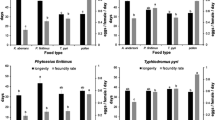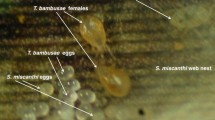Abstract
Do adult females of oligophagous species such as Neoseiulus fallacis (Garman) and Metaseiulus occidentalis (Nesbitt) show less intra- and interspecific predation on phytoseiids when other foods are scarce than polyphagous species such as Amblyseius andersoni Chant and Typhlodromus pyri Scheuten? We caged single adult females of each species without food with ten of their own eggs or larvae, with ten eggs or larvae of the other species or with ten nymphs or adult females of M. occidentalis (T. pyri for M. occidentalis). We assessed the ambulatory activity, survival time, egg levels and prey loss in each test. Polyphages (in particular T. pyri) lived longer than oligophages (in particular N. fallacis) without food. The small T. pyri detected its own stages and benefited most by feeding on small active stages of other species. Amblyseius andersoni, the largest mite, fed and gained the most of any species when held with nymphs and female adults. Metaseiulus occidentalis fed on eggs of all four species to enhance survival. The large hyperactive N. fallacis gained the least from these behaviours. Each mite seemed uniquely adapted to survive conditions of scarce prey and these behaviours may explain their roles in phytoseiid mite complexes. Overall, oligophagous adult females fed less and gained less by feeding on phytoseiids than did polyphagous adult females.
Similar content being viewed by others
References
Coop, L.B. and Croft, B.A. 1995. Neoseiulus fallacis: dispersal and biological control of Tetranychus urticae following minimal inoculations into a strawberry field. Exp. Appl. Acarol. 19: 31–43.
Croft, B.A. 1994. Biological control of apple mites by a phytoseiid mite complex and Zetzellia mali: long-term effects and impact of azinphosmethyl on colonization by Amblyseius andersoni (Acari: Phytoseiidae). Environ. Entomol. 23: 1317–1325.
Croft, B.A. and Croft, M.B. 1993. Larval survival and feeding by immature Metaseiulus occidentalis, Neoseiulus fallacis, Amblyseius andersoni and Typhlodromus pyri (Acari: Phytoseiidae) on life stages of Tetranychus urticae Koch and phytoseiid larvae. Exp. Appl. Acarol. 17: 685–693.
Croft, B.A. and Croft, M.B. 1996. Intra- and interspecific predation among adult female Metaseiulus occidentalis, Typhlodromus pyri, Neoseiulus fallacis and Amblyseius andersoni. Environ. Entomol. in press.
Croft, B.A. and MacRae, I.V. 1993. Biological control of apple mites: impact of Zetzellia mali (Acari: Stigmaedae) on Typhlodromus pyri Scheuten and Metaseiulus occidentalis (Nesbitt) (Acari: Phytoseiidae). Environ. Entomol. 22: 865–873.
Croft, B.A. and MacRae, I.V. 1992. Persistence of Typhlodromus pyri and Metaseiulus occidentalis (Acari: Phytoseiidae) on apple after inoculative release and competition with Zetzellia mali (Acari: Stigmaeidae). Environ. Entomol. 21: 1168–1177.
Croft, B.A., Kim, S.S. and Kim, D.I. 1995. Absorption and cannibalism: do phytoseiids conserve egg resources when prey densities decline rapidly? Exp. Appl. Acarol. 19: 347–356.
Croft, B.A., Riedl, H.W., Shearer, P. and Fields, G.J. 1990. Distribution of Metaseiulus occidentalis (Nesbitt) and Typhlodromus pyri Scheuten in apple orchards of the Hood River Valley, Oregon. Can. Entomol. 122: 5–14.
Croft, B.A., Messing, R.H., Dunley, J.E. and Strong, W.B. 1993. Effects of humidity on eggs and immatures of Neoseiulus fallacis, Amblyseius andersoni, Metaseiulus occidentalis and Typhlodromus pyri (Phytoseiidae): implications for biological control on apple, caneberry, strawberry and hop. Exp. Appl. Acarol. 17: 451–459.
Hadam, J.J., AliNiazee, M.T. and Croft, B.A. 1986. Phytoseiid mites (Parasitiformes: Phytoseiidae) of major crops in Willamette Valley, Oregon, and pesticide resistance in Typhlodromus pyri Scheuten. Environ. Entomol. 15: 1255–1263.
MacRae, I.V. and Croft, B.A. 1993. Influence of temperature on interspecific predation and cannibalism between Metaseiulus occidentalis (Nesbitt) and Typhlodromus pyri Scheuten (Acari: Phytoseiidae). Environ. Entomol. 22: 770–775.
Petersen, R.G. 1985. Design and Analysis of Experiments. Marcel Dekker Inc., New York.
Polis, G.A. and Meyers, C.A. 1989. The ecology and evolution of intraguild predation: potential predators that eat each other. Ann. Rev. Ecol. Syst. 20: 297–330.
Strong, W.B. and Croft, B.A. 1993. Predaceous phytoseiid mites associated with spider mites on hops in the Willamette Valley, Oregon. J. Entomol. Soc. BC, 90: 45–52.
Strong, W.B. and Croft, B.A. 1995. Inoculative release of phytoseiid mites into the rapidly expanding canopy of hop for control of Tetranychus urticae Koch. Environ. Entomol. 24: 446–453.
Walde, S.J., Nyrop, J.P. and Hardman, J.M. 1992. Dynamics of Panonychus ulmi and Typhlodromus pyri: factors contributing to persistence. Exp. Appl. Acarol. 14: 261–291.
Yao, D.S. and Chant, D.A. 1989. Population growth and predation interference between two species of predatory phytoseiid mites (Acarina: Phytoseiidae) in interactive systems. Oecologia 80: 443–455.
Zhang, Z.Q. and Croft, B.A. 1994. A comparative life history study of immature Amblyseius fallacis, Amblyseius andersoni, Typhlodromus occidentalis and Typhlodromus pyri (Acari: Phytoseiidae) with a review of larval feeding patterns in the family. Exp. Appl. Acarol. 18: 635–657.
Zhang, Z. Q. and Croft, B.A. 1995. Interspecific competition and predation in immature Amblyseius fallacis, Amblyseius andersoni, Typhlodromus occidentalis and Typhlodromus pyri (Acari: Phytoseiidae). Exp. Appl. Acarol. 19: 247–257.
Author information
Authors and Affiliations
Rights and permissions
About this article
Cite this article
Croft, B.A., Kim, S.S. & Kim, D.I. Intra- and interspecific predation on four life stage groups by the adult females of Metaseiulus occidentalis, Typhlodromus pyri, Neoseiulus fallacis and Amblyseius andersoni . Exp Appl Acarol 20, 435–444 (1996). https://doi.org/10.1007/BF00053307
Issue Date:
DOI: https://doi.org/10.1007/BF00053307




